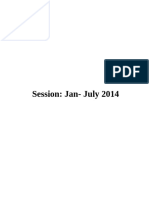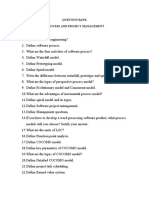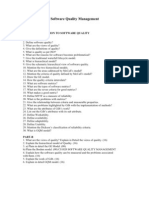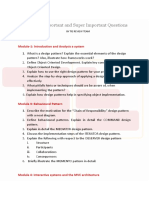0 ratings0% found this document useful (0 votes)
23 viewsSe Qbank
Se Qbank
Uploaded by
Mohammad samiThis document contains a question bank for a software engineering course divided into 5 units. The questions cover topics related to software processes, requirements engineering, design, architecture, and testing. There are short answer and long answer questions on various software development models, principles, methods and activities through the development life cycle.
Copyright:
© All Rights Reserved
Available Formats
Download as PDF, TXT or read online from Scribd
Se Qbank
Se Qbank
Uploaded by
Mohammad sami0 ratings0% found this document useful (0 votes)
23 views4 pagesThis document contains a question bank for a software engineering course divided into 5 units. The questions cover topics related to software processes, requirements engineering, design, architecture, and testing. There are short answer and long answer questions on various software development models, principles, methods and activities through the development life cycle.
Original Description:
Se fjdj
Original Title
SE QBANK
Copyright
© © All Rights Reserved
Available Formats
PDF, TXT or read online from Scribd
Share this document
Did you find this document useful?
Is this content inappropriate?
This document contains a question bank for a software engineering course divided into 5 units. The questions cover topics related to software processes, requirements engineering, design, architecture, and testing. There are short answer and long answer questions on various software development models, principles, methods and activities through the development life cycle.
Copyright:
© All Rights Reserved
Available Formats
Download as PDF, TXT or read online from Scribd
Download as pdf or txt
0 ratings0% found this document useful (0 votes)
23 views4 pagesSe Qbank
Se Qbank
Uploaded by
Mohammad samiThis document contains a question bank for a software engineering course divided into 5 units. The questions cover topics related to software processes, requirements engineering, design, architecture, and testing. There are short answer and long answer questions on various software development models, principles, methods and activities through the development life cycle.
Copyright:
© All Rights Reserved
Available Formats
Download as PDF, TXT or read online from Scribd
Download as pdf or txt
You are on page 1of 4
Software Engineering Question Bank
Unit-1: Short Questions
Define
a. Software Engineering. Differentiate the terms
software engineering, computer science and system
engineering.
2. List the steps of software process cycle.
3. Define agility. Write any two disadvantages of agile
process model.
4. Write any four advantages of agile process model.
5. Define Software process assessment. List and define its
types.
6. Discuss advantages and disadvantages of water fall model
7. When we use the incremental model?
8. What are the necessary conditions for implementing
evolutionary models?
9. Write any two advantages and disadvantages of
evolutionary process model.
10. Write a note on aspect software development process.
11. Justify the statement “ Agile yesterday, today and
tomorrow”
12. When to use agile model?
13. Write a note on software process maturity model.
Long Questions
14. Explain Software Process Framework.
15. Explain Water Fall Process Model
16. Compare Waterfall Model and Incremental Model
17. Compare Prototyping Model and Spiral Model
18. Explain briefly about Evolutionary Process Model
.
19. Explain Incremental Process Model
20. Explain Specialized Process Model.
21. Explain Unified Process Model
22. Explain Agile Process Model
23. Explain RAD.
Unit-2: Short Questions
24. Define Requirement Engineering?
25. Write the characteristics of Requirement Engineering.
26. Write and define the qualities of Requirements.
27. Write the importance of Requirement Engineering?
28. What is Requirement elicitation? Write its objectives.
29. j Justify the statement “Requirement engineering builds
bridge to design and construction”.
30. Define Analysis Model. Write the objectives of analysis
model.
31. Write a note on Negotiation of requirements.
32. Explain validation of Requirements.
33. Define Actor and Use case.
Long Questions
34. Explain principle of Software Engineering or explain SE
Principles.
35. Explain about Communication Principle
36. Explain Planning Principles.
37. Explain Modeling Principles.
38. What is testing? List and explain its types.
39. Explain Deployment Principles.
40. How we initiate Requirement Engineering Process.
41. Explain the Requirement Engineering Task
42. Define Elicitation of Requirements. List and explain the
elicitation method.
43. Explain the Elements of Analysis Model.
Unit-3: Short Questions
44. Define Analysis Model (requirement model). Write its
objectives.
45. Explain how analysis model is link between system
description and requirement model.
46. Write the analysis rules of thumb
47. Write about Object Oriented analysis.
48. Define Pattern. Write its importance.
49. What is Design Engineering?
50. What is Design Model?
51. Why Design Model is important?
52. Explain Deployment level design elements.
53. Write the characteristics of Design Class.
54. Write the Requirement Modeling Principles.
55. Discuss about Scenario Based Modeling
56. Explain Class based modeling.
57. Explain Functional Modeling.
58. Explain Behavioral modeling.
59. Explain Data Modeling.
60. Define Design Model. Explain with figure how design model is mapped from analys
61. Write design modeling principles.
62. Explain different types of Patterns.
63. Give the design pattern template
Unit-4: Short Questions
64. What is Software Architecture?
65. Why is Architecture important?
66. List the data design principles.
67. Define Architectural styles.
68. Differentiate Architectural Style and Architectural
Pattern.
69. What architectural style comprises?
70. Differentiate User’s Mental model and Implementation
Model.
71. Define Archetype. List and define its types.
72. Explain User Interface Design Process.
73. What is Design Evaluation?
Long Questions
74. Explain Architectural Description.
75. Explain Architectural Decision and Give its template
76. Explain Data design
77. Explain the taxonomy of Architectural Style
78. Explain Architectural Design.
79. Explain Golden Rules for User Interface.
80. Explain User Interface Analysis and Design.
81. Explain User Interface Analysis
82. Explain Interface Design Steps with example.
83. Explain Design Evaluation.
Unit-5: Short Questions
84. What is Software Testing?
85. Write the generic characteristics of Testing. of Testing?
86. What is the need of Software Testing?
87. Differentiate Validation and Verification.
88. Explain Big-Picture in Software Testing.
89. Write the Criteria too say testing is done.
90. Define good test. Write its properties.
91. Differentiate testing and debugging.
92. Define QA and SQA.
93. What are test cases?
Long Questions
94. Write any 12 difference between Black box and White
Box testing.
95. Explain Fundamentals of Testing
96. Explain Black Box testing
97. Explain White box testing.
98. Explain Basis Path in White Box Testing.
99. Explain Control Structure Testing.
100. Explain Basic Elements of SQA
101. Explain the different Core and additional Steps results
from Six- Sigma for Software engineering.
102. Explain Software Reliability and Availability.
103. Explain
i) Use of AI Model Reliability
ii) Software Safety.
You might also like
- Software Engineering Question BankDocument10 pagesSoftware Engineering Question BankakshaylikeNo ratings yet
- SE QuestionsDocument3 pagesSE QuestionsGouthami JukantiNo ratings yet
- SE Question Bank-1Document2 pagesSE Question Bank-1samacc0907No ratings yet
- Question BankDocument11 pagesQuestion Bankjain100% (2)
- S.E Final Q.BDocument5 pagesS.E Final Q.BbhagyashribbsccsNo ratings yet
- Question Bank Software EngineerningDocument9 pagesQuestion Bank Software EngineerningZaheer AbbasNo ratings yet
- SE Important QuestionsDocument2 pagesSE Important Questionsd87522585No ratings yet
- Software Engineering Question BankDocument5 pagesSoftware Engineering Question BankkunjasrujanasriNo ratings yet
- SE Que Lis 160701Document5 pagesSE Que Lis 160701has_meceNo ratings yet
- Course File Software EngineeringDocument23 pagesCourse File Software Engineeringshrivastava.himanshu2805No ratings yet
- Imp Que SeDocument2 pagesImp Que Se07Karan DesaiNo ratings yet
- CP7007-Software Requirement Engineering PDFDocument8 pagesCP7007-Software Requirement Engineering PDFsaranya100% (1)
- AssinmentDocument2 pagesAssinmentvolatility75sNo ratings yet
- SE Module Wise QuestionsDocument3 pagesSE Module Wise QuestionsVailantan FernandesNo ratings yet
- Question BankDocument3 pagesQuestion BankZala RajveersinhNo ratings yet
- SE Question Bank-5Document4 pagesSE Question Bank-5SakshiNo ratings yet
- SE Assignment1Document3 pagesSE Assignment1ayushisavaliya35No ratings yet
- SE QuesDocument2 pagesSE Queskaps_er_3No ratings yet
- Mc9233 Software EngineeringDocument10 pagesMc9233 Software EngineeringnovfelnawzinNo ratings yet
- Se - Cia I - QBDocument5 pagesSe - Cia I - QBsajay676767No ratings yet
- Department of Computer Science and Engineering Question BankDocument11 pagesDepartment of Computer Science and Engineering Question BankDevi SriNo ratings yet
- 15Cs42: Software Engineering Question BankDocument6 pages15Cs42: Software Engineering Question BankSyeda AfreenNo ratings yet
- QB M1 and M2Document2 pagesQB M1 and M2basavarajturamari58No ratings yet
- SE (Q Bank)Document3 pagesSE (Q Bank)SHARK GAMINGNo ratings yet
- Software Testing and Quality Assurance - : Unit - 1 Two Marks QuestionsDocument5 pagesSoftware Testing and Quality Assurance - : Unit - 1 Two Marks QuestionsAanchal Padmavat100% (2)
- SE $ STQuestion BankDocument3 pagesSE $ STQuestion Bankallroundervijay123No ratings yet
- SADP Super Important - 23Document2 pagesSADP Super Important - 23Gaurav SNo ratings yet
- $RHBT115 PDFDocument8 pages$RHBT115 PDFAnonymous s8OrImv8No ratings yet
- Unit Wise Possible Questions: Software EngineeringDocument2 pagesUnit Wise Possible Questions: Software EngineeringRama Sree50% (2)
- Assignment 1-5Document3 pagesAssignment 1-5rohitmhaske0208No ratings yet
- Roever Engineering Colleges Deparment of CSE Unit I Software Process and Agile Development Part - ADocument3 pagesRoever Engineering Colleges Deparment of CSE Unit I Software Process and Agile Development Part - AsenthilNo ratings yet
- SOTWARE ENGINEERING-case Tools LabDocument2 pagesSOTWARE ENGINEERING-case Tools Labmuhammadkamran05100% (1)
- SE Remedial Questions 2023 24Document2 pagesSE Remedial Questions 2023 24jaishujaiswal9920No ratings yet
- CP7301-Software Process and Project Management PDFDocument7 pagesCP7301-Software Process and Project Management PDFsaraswathiNo ratings yet
- SE QuestionBankDocument12 pagesSE QuestionBanksharmadhruv2808No ratings yet
- QuesDocument3 pagesQuesMD ARIFNo ratings yet
- 146 - CS8494, CS6403 Software Engineering - Question BankDocument5 pages146 - CS8494, CS6403 Software Engineering - Question Banktamilarasi87thulasiNo ratings yet
- Software Engineering QUESTION BANKDocument11 pagesSoftware Engineering QUESTION BANKHema MaheNo ratings yet
- Principles of Software Engineering-QuestionsDocument7 pagesPrinciples of Software Engineering-Questionsjava games fan clubNo ratings yet
- Question Bank For Software Architecture Regulation 2013Document10 pagesQuestion Bank For Software Architecture Regulation 2013PRIYA RAJI100% (2)
- Cse3050 SPM QB Mid TermDocument9 pagesCse3050 SPM QB Mid Termkishorekr2929No ratings yet
- Syit Software Engineering Question BankDocument3 pagesSyit Software Engineering Question Bankyadneshkadam9892No ratings yet
- SQM Important QuestionsDocument4 pagesSQM Important QuestionsShankar Prakash GNo ratings yet
- Question Bank Software EngineeringDocument2 pagesQuestion Bank Software EngineeringRudra SinghNo ratings yet
- SADP Important and Super Important Questions: Module-1: Introduction and Analysis A SystemDocument3 pagesSADP Important and Super Important Questions: Module-1: Introduction and Analysis A SystemS SaikumarNo ratings yet
- SWENGGG QBankDocument6 pagesSWENGGG QBankKarthick ThiyaguNo ratings yet
- SE QB - 2011 - 1st EditionDocument21 pagesSE QB - 2011 - 1st EditionDhanaraj ShanmugasundaramNo ratings yet
- Sqa Question BankDocument7 pagesSqa Question Bankfutureofficial24No ratings yet
- Important Questions of SE: Chapter 1:-Introduction To Software and Software EngineeringDocument4 pagesImportant Questions of SE: Chapter 1:-Introduction To Software and Software EngineeringSanjeev ChaudharyNo ratings yet
- PDDDocument5 pagesPDDSimbhu Ashok CNo ratings yet
- MSS-Question BankDocument3 pagesMSS-Question BankNandana DasNo ratings yet
- Questions Software Engineering (1) (2015!09!03 05-47-50 UTC)Document4 pagesQuestions Software Engineering (1) (2015!09!03 05-47-50 UTC)Miguel Perez GarciaNo ratings yet
- Se-Previous Question Papers Unit-IDocument3 pagesSe-Previous Question Papers Unit-IVamshi KrishnaNo ratings yet
- Ase QBDocument5 pagesAse QBfakeme9971No ratings yet
- SE Question Bank - Autonomous - 2020Document4 pagesSE Question Bank - Autonomous - 2020divijareddy0502No ratings yet
- 15,16 2 Mark SEQADocument32 pages15,16 2 Mark SEQAbhuvi2312No ratings yet
- Mastering Software Engineering: From Basics to Expert ProficiencyFrom EverandMastering Software Engineering: From Basics to Expert ProficiencyNo ratings yet
- Mastering the Craft: Unleashing the Art of Software EngineeringFrom EverandMastering the Craft: Unleashing the Art of Software EngineeringNo ratings yet



























































